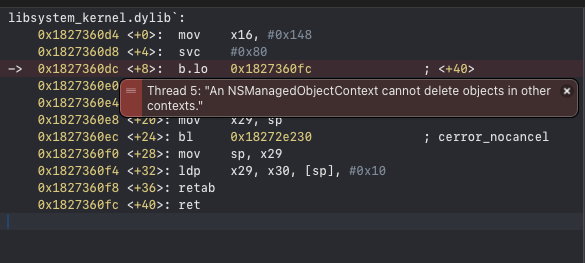
Using ModelActor in SwiftData
With the introduction of SwiftData at WWDC 2023, we have seen the further Swift-ifaction of older APIs. While Core Data is a tried and true technology, SwiftData allows for the use of Swift in defining models and relationships. This is as opposed to Core Data's own format just as SwiftUI eliminated the need for Storyboards and Xibs.
One of the major challenges with using SwiftData is its introduction in a post-async-await world. This introduces its own challenges. Challenges which can be difficult to decipher since Apple has abstracted much of that away in layers of Macros and Property Wrappers.
Beta Testing SwiftData
During my (second) attempt at building Bushel, SwiftData was one of the leading reasons to target Sonoma as opposed to older operating systems. As I built Bushel while SwiftData was in beta, I began to realize there was some I was missing in my implementation. It become all too evident to me what I was doing wrong: Threading. If you've run into crashes while integrating SwiftData. You've seen these crashes all too much. My last minute fix was simple: @MainActor.
This fixed the problem but it was clear to me that this wasn't ideal. Moving database work to the main thread fixed the problem but it seemed sub-optimal and inefficient. There had to be a better way.
Creating Our ModelActor
This is where @ModelActor comes in. ModelActor introduces a way to interface with the database (i.e. ModelContext) in a mutually-exclusive way. This means the database can only be accessed one at a time as required by SwiftData. In other words I no longer require all database actions be run on the MainActor but a background actor shared by the application.
It was unclear to me when in development ModelActor was introduced as I couldn't find a WWDC video or much documentation on the subject. However there were a two sources which helped spark the beginning of this transition.
This article from Vyacheslav Ansimov introduces the how a background ModelActor would work.
More importantly Franz Busch's talk at Server Side Swift 2024 showcases the important with pattern to structured concurrent which we'll use here:
The way we'll implement our ModelActor is by essentially using the with pattern to interface with the ModelContext:
extension ModelActor {
public func withModelContext<T: Sendable>(
_ closure: @Sendable @escaping (ModelContext) throws -> T
) async rethrows -> T {
let modelContext = self.modelContext
return try closure(modelContext)
}
}
This will easily work in our application however there are a few remaining things I need to do the application:
- Create a Protocol for this type to remove direct references to this type
- Create an
@Environmentvalue so I can use this throughout the application
Abstracting Our ModelActor
There are several reason I want to abstract our ModelActor extension into a protocol. Such as easier mocking for unit tests as well as removing direct references (as I use a lot). If you are interested in learning more about dependency management, I highly recommend checking this article out.
So let's create a abstract Database protocol:
public protocol Database: Sendable {
func withModelContext<T>(_ closure: @Sendable @escaping (ModelContext) throws -> T)
async rethrows -> T
}
extension ModelActor where Self: Database {
public func withModelContext<T: Sendable>(
_ closure: @Sendable @escaping (ModelContext) throws -> T
) async rethrows -> T {
let modelContext = self.modelContext
return try closure(modelContext)
}
}
I want to note that the method is async. This is to take into account the fact that if this is implemented by an actor when the method will be called outside of the actor it will be required to be asynchronous to ensure exclusivity.
Now we can let the compiler know that ModelActorDatabase implements Database:
@ModelActor
public actor ModelActorDatabase: Database {}
This is a great step but now we need to make sure that our SwiftUI Views have access to this object. The best way to do this is by creating a new EnvironmentKey.
Environmentally Friendly
SwiftUI provides an API to add new values to the @Environment property wrapper. However we'll need to implement a defaultValue for our Database. What do we want if the developer (me) forgets to setup the Database? Taking a page from what .modelContainer does I'll create a DefaultDatabase:
private struct DefaultDatabase: Database {
static let instance = DefaultDatabase()
// swiftlint:disable:next unavailable_function
func withModelContext<T>(_ closure: (ModelContext) throws -> T) async rethrows -> T {
assertionFailure("No Database Set.")
fatalError("No Database Set.")
}
}
In this implementation, the method crashes. This ensures the developer (me) doesn't forget to set the Database. Now we can setup our Environment value:
extension EnvironmentValues {
@Entry public var database: any Database = DefaultDatabase.instance
}
extension Scene {
public func database(_ database: any Database) -> some Scene {
environment(\.database, database)
}
}
extension View {
public func database(_ database: any Database) -> some View {
environment(\.database, database)
}
}
Now in the root SwiftUI Scene we can call the modifier to pass our ModelActorDatabase:
var body: some Scene {
WindowGroup {
RootView()
}.database(ModelActorDatabase(modelContainer: ...))
}
and then reference it in our SwiftUI View:
@Environment(\.database) private var database
However we'll notice two issues with this approach:
- That our calls are still running on the main thread. 😫
- We'll receive a slightly opaque crashing message:
An NSManagedObjectContext cannot delete objects in other contexts.

Context Switching
If you are familiar with Core Data, you probably know that you should use a single NSManagedObjectContext throughout your app. The issue here is that our initializer for ModelActorDatabase will be called each time the SwiftUI View is redraw. So if we look at the expanded @ModelActor Macro for our ModelActorDatabase, we see that a new ModelContext (SwiftData wrapper or abstraction, etc. of NSManagedObjectContext) is created each time:
public init(modelContainer: SwiftData.ModelContainer) {
let modelContext = ModelContext(modelContainer)
self.modelExecutor = DefaultSerialModelExecutor(modelContext: modelContext)
self.modelContainer = modelContainer
}
This means if we pass SwiftData models throughout our app, we will be running our models through a variety of ModelContext objects which will result in a crash. The best approach to this is create a singleton for the Database and ModelContainer which ensures it to be shared across the .environment and application:
public struct SharedDatabase {
public static let shared: SharedDatabase = .init()
public let schemas: [any PersistentModel.Type]
public let modelContainer: ModelContainer
public let database: any Database
private init(
schemas: [any PersistentModel.Type] = .all,
modelContainer: ModelContainer? = nil,
database: (any Database)? = nil
) {
self.schemas = schemas
let modelContainer = modelContainer ?? .forTypes(schemas)
self.modelContainer = modelContainer
self.database = database ?? ModelActorDatabase(modelContainer: modelContainer)
}
}
Then in our SwiftUI code, we call:
var body: some Scene {
WindowGroup {
RootView()
}
.database(SharedDatabase.shared.database)
/* if we wish to continue using @Query
.modelContainer(SharedDatabase.shared.modelContainer)
*/
}
The other issue of course is that our calls are still running on the main thread.
What is happening? My thought is that all methods of an actor are called on the thread the object is created on. Therefore if we create ModelActorDatabase on the main actor (which is likely with SwiftUI) every method inside the actor will be called on the main thread. This is not ideal when it comes to the user experience of the app.
To resolve this we'll need to allow the Database initializer on the MainActor but ensure the database calls will be run in the background.
Moving to the Background
This is where a new Database implementation for wrapping our ModelActorDatabase comes in. Introducing the BackgroundDatabase:
public class BackgroundDatabase: Database {
private actor DatabaseContainer {
private let factory: @Sendable () -> any Database
private var wrappedTask: Task<any Database, Never>?
fileprivate init(factory: @escaping @Sendable () -> any Database) {
self.factory = factory
}
fileprivate var database: any Database {
get async {
if let wrappedTask {
return await wrappedTask.value
}
let task = Task {
factory()
}
self.wrappedTask = task
return await task.value
}
}
}
private let container: DatabaseContainer
private var database: any Database {
get async {
await container.database
}
}
internal init(_ factory: @Sendable @escaping () -> any Database) {
self.container = .init(factory: factory)
}
public func withModelContext<T>(_ closure: @Sendable @escaping (ModelContext) throws -> T)
async rethrows -> T
{ try await self.database.withModelContext(closure) }
}
...
What is this doing to ensure background execution? Firstly we create an inner actor type which will provide exclusivity into the actual Database implementation while ensuring the Database is initialized on a background thread. We are using Matt Massicotte's recipe for Structure Concurrency using an unstructured Task here. Check out his episode here for more details on the complexities of concurrency.
With this update, every time the container.database is accessed the ModelActorDatabase will be on a background actor.
Then we update our SharedDatabase single:
public struct SharedDatabase {
private init(
schemas: [any PersistentModel.Type] = .all,
modelContainer: ModelContainer? = nil,
database: (any Database)? = nil
) {
self.schemas = schemas
let modelContainer = modelContainer ?? .forTypes(schemas)
self.modelContainer = modelContainer
self.database = database ?? BackgroundDatabase(modelContainer: modelContainer)
}
}
This time our new database works perfectly! 🥳
How to be a Model Actor within SwiftData
Adopting ModelActor with SwiftData presents a significant enhancement to the efficiency within SwiftUI applications. By transitioning database work to a background thread, we ensure a smoother user experience, particularly in scenarios where database interactions are involved.
- Relying solely on
@MainActorseemed to solve one problem but created new ones when it came to user experience. - By using ModelActor and creating an abstraction into a protocol (i.e.
Database), we've modularized database interactions, making our codebase cleaner and more maintainable. - Use the same ModelContext throughout your app to avoid crashes due to context switching.
- The introduction of
BackgroundDatabasefurther refines this, ensuring that database operations occur asynchronously on a separate thread, enhancing responsiveness within our SwiftUI application.
While the transition to ModelActor and BackgroundDatabase necessitated some refactoring and adjustments, the end result significantly improves the scalability and responsiveness of our application. As we get closer to Swift 6, perhaps there will be less ambiguity with regard the Actors and Concurrency. Hopefully you found this article helpful for you, it underscores the importance of continuously refining our code in order to deliver exceptional user experiences.